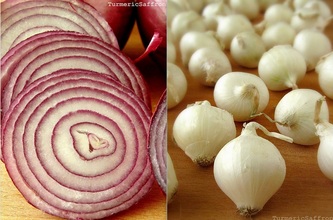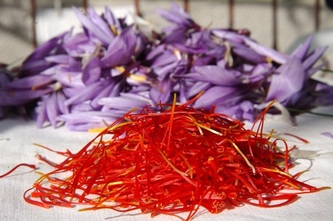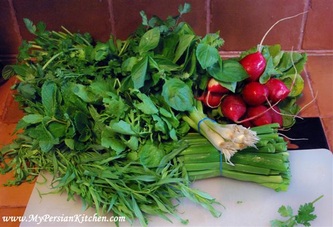|
Brief on Persian Cooking Persian or Iranian food is prepared with very diverse items. Cereals, grains, vegetables, herbs, fruits, spices and nuts are used frequently in popular recipes: polow, chelow, stews, kabob, kookoo... There are regional variations to each traditional recipe and so there is a wide range of combination open to one's choice. The following tips are to help you feel confident and try to prepare your own persian foods and enjoy. Cooking Omelet or Kookoo Eggplant, squash, green beans, faba beans, green peas, spinach, cauliflower and many other vegetables are used to make omelet or Kookoo. For making an omelet you need to beat well the eggs (4-6), add baking soda (1tsp), salt and pepper and spices. Add already cooked tender vegetables of your selection (1-2cups). Mix and pour into hot nonstick pan over high heat, lift the sides to check thickening of the egg and fold the omelet when the bottom side is lightly brown, turn once. Serve immediately. Tips for fast cooking omelet 1. Use nonstick saucepan 2. Heat low cholesterol vegetable oil for cooking 3. Chop broccoli and cauliflower cook fast in boiling water 4. Chop eggplant, squash, onion and fry while stirring 5. Smash boiled potatoes 6. Chop finely the green beans and boil in water until tender 7. Use very finely chopped fresh dill,coriander, parsley, Persian leek 8. Add a bit of butter (1tsp) for flavoring Cooking 'Ash'
'Ash' is a high calorie and high protein high fiber food. It contains much vegetables like onion, beet root and leaves, spinach, different beans, bulgur, barley or oatmeal, rice and always a combination of aromatic herbs. 'Ash' is finally decorated with minced golden fried onion, saffron and mint before being served. Some recipes require beef or lamb meat, as chunks or small meatballs. Tips for fast cooking ‘Ash’ 1. When you like to cook Ash with no plan ahead, always stock halfway cooked beans packages in the freezer. 2. Flaked wheat, barley and oatmeal cook much faster and can be used readily contrary to the grains which should be soaked overnight before cooking. 3. Bring to boil 4-6 cups of water in a deep pan, add the step2 beans and cover. 4. Add turmeric at this time and lower the heat, stir occasionally. 6. Add rice, barely or oatmeal. 5. Chop vegetables finely and add to the pan. 6. Chop herbs and spinach finely and add later when the rest is ready. 7. Add finely sliced fried onions at the end and stir. 8. Taste to add salt and pepper and serve with decoration on top. Cooking rice Indian basmati rice is found in groceries. This rice needs some preparation: occasional grit to remove and several gentle washes in warm water before cooking. there three different types of rice preparation: Kateh, Chelow and Polow Tips for cooking rice 1. Basmati rice doesn’t need to be soaked. 2. The cooking time is dependent to the number of servings. Kateh 1. One small size serving rice (2cups), water (3cups) and salt (1tsp) are added to a nonstick pan and placed over high heat to boil 2. Stir and continue on medium heat to simmer, uncovered. 3. Add oil and stir gently when water absorbed. 4. Reduce heat and place the lid, wrapped in a clean towel. 5. Cook for 20-30 minutes over low heat. Chelow 1. One small serving rice (2cups) is boiled in salted water (5cups), drained and rinsed before adding into nonstick oiled pan. 2. Yogurt and seasonings, if used, are added at bottom of the pan and the rinsed rice is added on the top. 3. Put pan over medium heat covered with towel wrapped lid until vapor starts coming out of the towel. 4. Lower the heat and let steam for 25 minutes. Longer cooking time gives thicker crust: ‘tah-dig’. Polow This preparation differs from Chelow, only for its additional ingredients (i.e. cooked meat, chicken or shrimps, chopped fresh herbs or fried vegetables, small berries and all seasonings) that are mixed in, added or layered in the pan, at the steaming stage. Don’t use spatula to serve the cooked hot and tender rice, it will damage the grains, just invert the pan over a large plate, or gently shake it over one, to take the rice into the serving plate. Crusty ‘tah-dig’ is made best in nonstick pans. Cooking stews ('Khoresht') Persian stews 'Khoresht' or 'Khoresh', are prepared with vegetables, fruits and fruit pastes, herbs and condiments and spices, lamb meat, chicken and even eggs. There are made with various tastes from sweet to sweet and sour to sour. Regional recipes are abundant. Concerning the ratio for herbs to add: parsley, coriander, Persian leek or 'tareh', and fenugreek, the first too are used 2 times more than 'tareh' and fenugreek is used the least. Tips on cooking stews 1. Usually stews contain 2-3 Tbsp golden fried onion=3-4 onions uniformly sliced and fried on low heat 2. Rinse meat under fresh water, chop and mix with fried onion 3. Add spice to your taste 4. Add water (4-6 cups) and cook over medium heat 5. Cover the pan during cooking until the meat is tender cooked 6. Mix cooked or fried vegetables/fresh chopped herbs/fruits, now 7. Stir only moderately 8. Add salt and lemon juice after all ingredients are cooked 9. Uncover the pan to let evaporate extra water 10. A tasty stew is not much watery when served Read more about food ingredients and recipes: http://www.wholespice.com/ http://www.earthy.com/ http://www.sunset.com/ http://fr.wikipedia.org/wiki/Cuisine_iranienne http://turmericsaffron.blogspot.com/ Comments are closed.
|
|
Archives
July 2020
Categories
All
|



 RSS Feed
RSS Feed
